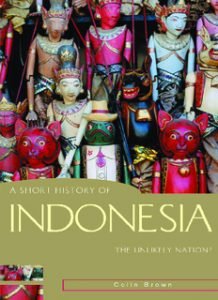A Short History of Indonesia
A Short History of Indonesia The first draft of this book was written in the second half of 2000, while I was on study leave from Flinders University. For part of this time, I was a Visiting Fellow at the International Institute for Asian Studies in Leiden, the Netherlands. I gratefully acknowledge the warm collegial support I received during my stay there, from the Director Professor W. A. L. Stokhof, and all his colleagues.

A Short History of Indonesia PDF
What’s in a name?
One of the problems in thinking and writing about Indonesia at the beginning of the twenty-first century is working out just what ‘Indonesia’ refers to. Since its coinage, in the mid-nineteenth century, the word has acquired various geographical, political, and social meanings, of which the original geographical meaning is perhaps the least controversial.
A British geographer, James Richardson Logan, coined the name to refer to the vast archipelago, with many thousands of islands, off the southeast tip of mainland Asia. A combination of ‘India’ and nêsos (Greek for ‘islands’), Indonesia meant ‘Indian islands’.
In part, the name reflected the fact that for many European writers of the day the Indonesian archipelago was seen as an extension of the Indian subcontinent, especially in cultural terms. The British also used the term ‘Further India’ to describe the region; the Dutch called their colonial possessions in the islands Nederlands Indie, meaning ‘Dutch India’ or ‘Dutch Indies’.
More generally, as the name India had not yet taken on the geographically precise meaning it has today, in some senses, India meant simply what modern Europeans now refer to as Southeast Asia. By the early part of the twentieth century, the term ‘Indonesia’ was taking on political and social connotations, both for the nationalist movement seeking to free the archipelago of its Dutch colonial rulers and for the Dutch themselves.
By the late 1920s, the nationalist movement was using the name to describe both the political entity it was hoping to bring into existence in place of the Dutch colonial state, and the social community, the nation, which was to inhabit that state.
The nationalists were using the word in the names of their political parties; calling themselves Indonesians; referring to their language—a modernized form of Malay—as Indonesian. The Dutch authorities, seeking to deny both these meanings, refused to use the word in any official way and did their best to deny that it had any meaning.
Disclaimer:- Dev Library is not the owner of the books and neither does it create books. We just provide the links to the book for the rural and poor students who can’t afford to buy books. Those E-Books and PDFs are already available on the internet. For any reason, if someone thinks that I’m violating any laws or if anyone has any issues regarding this, please feel free to Contact Us.

Hi, I’m Dev Kirtonia, Founder & CEO of Dev Library. A website that provides all SCERT, NCERT 3 to 12, and BA, B.com, B.Sc, and Computer Science with Post Graduate Notes & Suggestions, Novel, eBooks, Biography, Quotes, Study Materials, and more.








